#columbia tristar television
Explore tagged Tumblr posts
Text
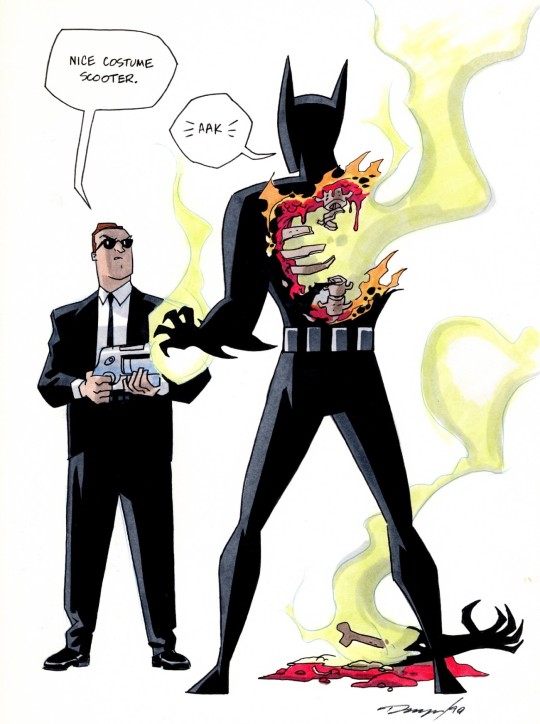
Artwork by Darwyn Cooke. Drawn the day the MIB show beat Batman Beyond in the ratings. Darwyn worked on both tv series.
#darwyn cooke#batman beyond#men in black#dcau#dc comics#Columbia TriStar Television#men in black the series
151 notes
·
View notes
Text

Fan art of Jay Sherman from The Critic. Digitized in Ibis Paint X.
The Critic (C) Al Jean and Mike Reiss/Gracie Films/Columbia TriStar Television
#sony pictures television#the critic#al jean#mike reiss#jay sherman#jon lovitz#fan art#digital#art#ibis paint x#gracie films#columbia tristar television
4 notes
·
View notes
Text
Screenwriter, Producer and Author Steven L. Sears on 9/14 - TOMORROW!
This virtual event will provide valuable insights and tips on crafting compelling scripts for film and television production, including, the intricacies of developing unique characters, a strong premise and story, finding your voice, exploring script development and the writer’s vision.


Steven L. Sears has worked as a Writer, Story Editor, Producer and Creator in Television, Film, digital media and animation. His lengthy career has encompassed over fifteen separate Television series, and development deals with many major studios in the industry, including Columbia Studios, Sony/Tristar Television, Rhysher Entertainment, Artists Inc., Cookie Jar Entertainment, Digital Pictures and many others.
More detailed Info here.
#scriptwriting#screenwriting#script#write#scriptchat#amwriting#writingcommunity#writingcorner#writersoftumblr#writersontumblr#writersonwriting#scriptwritersnetwork#screenwritersnetwork
0 notes
Photo

Paul Edward Haggis was born on March 10, 1953. He is a Canadian screenwriter, film producer, and director of film and television. He is best known as screenwriter and producer for consecutive Best Picture Oscar winners: Million Dollar Baby (2004) and Crash (2005), the latter of which he also directed. Haggis also co-wrote the war film Flags of Our Fathers (2006) and the James Bond films Casino Royale (2006) and Quantum of Solace (2008). He is the creator of the television series Due South (1994–1999) and co-creator of Walker, Texas Ranger (1993–2001), among others. Haggis is a two-time Academy Award winner, two-time Emmy Award winner, and seven-time Gemini Award winner. He also assisted in the making of the "We Are the World 25 For Haiti"
Haggis began to work as a writer for television programs, including The Love Boat, One Day at a Time, Diff'rent Strokes, and The Facts of Life. With The Facts of Life, Haggis also gained his first credit as producer. During the 1980s and 1990s, Haggis wrote for television series including thirtysomething, The Tracey Ullman Show, FM, Due South, L.A. Law, and EZ Streets. He helped to create the television series Walker, Texas Ranger; Family Law; and Due South. Haggis served as executive producer of the series Michael Hayes and Family Law. In 1999, he signed a first look deal with Columbia TriStar Television.
He gained recognition in the film industry for his work on the 2004 film Million Dollar Baby, which Allmovie described as a "serious milestone" for the writer/producer, and as "his first high-profile foray into feature film". Haggis had read two stories written by Jerry Boyd, a boxing trainer who wrote under the name of F.X. Toole.
Haggis later acquired the rights to the stories, and developed them into the screenplay for Million Dollar Baby. Clint Eastwood portrayed the lead character in the film. Eastwood also directed the film, and used the screenplay written by Haggis. Million Dollar Baby received four Academy Awards including the Academy Award for Best Picture.
After Million Dollar Baby, Haggis worked on the 2004 film Crash. Haggis came up with the story for the film on his own, and then wrote and directed the film, which allowed him greater control over his work. Crash was his first experience as director of a major feature film. Highly positive upon release, critical reception of Crash has since polarized, although Roger Ebert called it the best film of 2005.
Crash received Academy Award nominations for Best Picture and Best Director, in addition to four other Academy Award nominations. Haggis received two Academy Awards for the film: Best Picture (as its producer), and Best Writing for his work on the screenplay. With Million Dollar Baby and then Crash, Haggis became the first individual to have written Best Picture Oscar-winners in two consecutive years.
Haggis said that he wrote Crash to "bust liberals", arguing that his fellow liberals were not honest with themselves about the nature of race and racism because they believed that most racial problems had already been resolved in American society.
He has been a member of the Academy of Motion Picture Arts and Sciences in the Writer's Branch since 2005. This allows him to vote on the Academy Awards.
Daily inspiration. Discover more photos at http://justforbooks.tumblr.com
17 notes
·
View notes
Photo

Jennifer Aniston, 1992
Hulton Archive / © Columbia Tristar Television
6 notes
·
View notes
Note
What if AiCAL was distrubited by CTTV and WBTV ( Columbia TriStar Television, Warner Bros. Television)?
Again, I’m not much of an AiC person myself, so I don’t have a strong opinion about it. I also don’t know much about TV companies in general. However, I’m all for anything that makes it easier for anybody to watch any versions of Care Bears that they like.
4 notes
·
View notes
Video
youtube
#Men in Black: The Series#The Men in Black#Lowell Cunningham#Duane Capizzi#Jeff Kline#Ed O'Ross#Gregg Berger#Keith Diamond#Jennifer Lien#Charles Napier#Vincent D'Onofrio#David Warner#Amblin Television#Adelaide Productions#Columbia TriStar Television#Columbia TriStar Television Distribution#The WB#kids' wb
0 notes
Text
The lost Supergirl

To its detractors the 1984 Helen Slater Supergirl is an underwhelming, disjointed, and self-contradictory attempt to profit from the Superman franchise beyond the Man of Steel. To its supporters the 1984 Supergirl is a much misunderstood blending of super-heroics and fairy-tales, creating a magical story of adventure and courage. But no matter what your take on this movie, no one can deny that it failed to meet box office expectations and did not garner anything like the same reputation as Chris Reeve’s first two iconic Superman outings.
But with the passing of time comicbook fans seem to have slowly mellowed towards Slater’s Supergirl. Sure, it may never be considered a classic, but many fans now acknowledge that Helen Slater’s time in the red cape has a lot of charming qualities, qualities that are sadly lacking in many of DC’s modern offerings.
So, what caused this shift in attitudes?
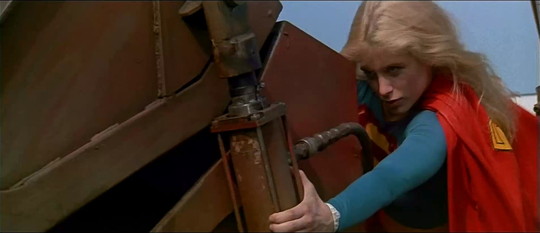
Well, thanks to the internet, today’s fans have a greater awareness of the intentions of director Jeannot Szwarc, who (we now recognise) was pitching at a younger audience than the Superman movies -- hence the looser fairy-tale quality of the plot. But, more importantly, there’s also a growing awareness that many of the movie’s weaknesses were made far more glaring by the distributor’s brutal editing for US markets.
As more and more of the cutting room floor footage has been seen, so criticism has softened. Although still far from perfect, 2000′s extended 138 minute cut is generally recognised as a more balanced and coherent experience than 1984′s US theatrical version of just 105 minutes. But fans have speculated that yet more footage is still to be found. Rumours circulate on the far flung reaches of the internet concerning a possible 150 minute edit, smoothing over even more of the disjointed elements of the story.
In this article I want to first attempt a fact-packed recap of the editing history of the Supergirl movie, noting when and why its numerous cuts were created; then I want to briefly speculate on what might be in the still-missing 12 minutes (if indeed they exist), by pulling together the various rumours and looking at their evidence.
So, let’s begin...

From silver screen to small screen
Supergirl got its debut in London on Thursday 19th July 1984, as part of a Royal Charity Premiere screening attended by Princess Michael of Kent (whose husband is the current Queen’s first cousin, as I’m sure everyone knows(!)) This UK version was distributed by Columbia-EMI-Warner and ran at 124 minutes. Initial critical reaction was mixed, leaning more towards underwhelmed.
As US fans waited for the Maid of Might to fly onto their cinema screens, the movie began to open around the world. Ireland and Japan got Supergirl just days after the UK, then August saw Supergirl open in the Philippines, Australia, and Spain. In October it was the turn of France and Canada. Meanwhile Kara Zor-El fans in her (adopted) home country had no choice but to wait... and wait... and wait... The delay in the US release was caused by Warner Bros. dropping out of negotiations to promote and distribute the film in US theatres midway through production. As the movie was in post production, and overseas distribution deals were being struck, the Salkind family (the producers) scrambled to find an alternative distributor for their biggest market.
Finally, on Wednesday 21st November 1984, the Maid of Might launched onto US screens thanks to TriStar Pictures, but the switch in distributor had not been without major consequences. American Supergirl fans were treated to an experience that had been cut down to just 105 minutes, removing key exposition scenes from a movie that was already criticised for struggling with plot coherence. Supergirl grossed $5.7m on its opening weekend, and went on bring in $13.6m in the US market. On an estimated production budget of $35m, it was not considered a success.
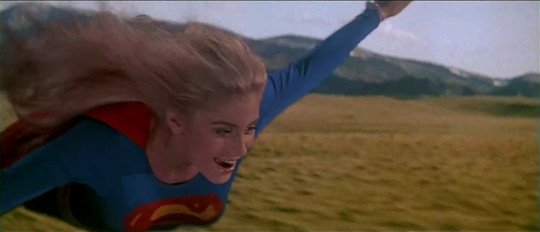
At the same time as the US theatrical release, a 125 minute LaserDisc version appeared in Japan, marking the first time fans could watch the Girl of Steel in the comfort of their own Fortress of Solitude. The advertised 125 minute running time likely represents a rounding error rather than 1 minute of new material. Although not sold into US markets, some copies apparently did cross the Pacific. The LaserDisc version was likely a pan-and-scan copy (no documentation suggests widescreen), with Supergirl’s wide cinematic 2.35:1 image cropped drastically to fit television’s nearly square 4:3 ratio.
Pan-and-scan would also have been done to the initial VHS release into US markets by U.S.A. Home Video in 1985, which used the 105 minute cut that had appeared in US cinemas the year before. In 1987 a second pan-and-scan edit was created by TriStar for HBO‘s cable tv screenings, which was then used by the ABC Network when it broadcast a brutal 92 minute cut in February 1987. (It was common practice for ad-supported tv to heavily edit movies, making space for commercials without stretching the running time too far.) This super-slimline cut was later thrown together with other Superman movies into a tv syndication package by Viacom. The Internet Movie Database suggests that there was also a VHS cut that ran to just 89 minutes -- this may have been either the Avid Home Video release (1991) catalogued on the same site, or it may refer to an unknown overseas VHS release.
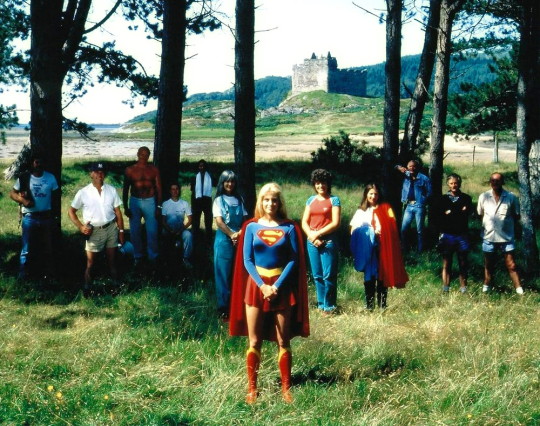
Lurking in the depths of the vaults
By the late 1990s the full 124 minute cut of Supergirl had still never been legitimately made available in the US. The rights to the Supergirl movie had subsequently been snapped up as part of a bundle of films by Canal + Distribution in France, and they allowed Anchor Bay Entertainment to release the two hour so-called International Cut on VHS. Many Supergirl fans now thought that they, at last(!), had copies of the most complete version of the film. But rumours quickly started to circulate that this was far from the case.
Not long after the International Cut’s release, speculation began that Canal + had found something interesting lurking amidst the dusty film cans they’d acquired as part of their rights acquisitions. A previously unknown 138 minute cut of Supergirl featuring a mono soundtrack had been unearthed, which quickly acquired the moniker of the Director’s Cut.

(Note: one citation-free internet comment suggests that the Director’s Cut was actually discovered at Pinewood Studios, in a box marked “do not use”. Although the early Superman / Supergirl movies were filmed at London’s Pinewood soundstages, it seems odd that a finished edit of the film, complete with soundtrack, would be discovered there.)
In mid-2000 Anchor Bay Entertainment released a two disc DVD set featuring both the 124 minute International Cut, and the new 138 minute Director’s Cut, both in widescreen format (2.35:1 letter-boxed to widescreen tv’s 16:9 ratio.)
So, thought fans, surely this is the definitive Helen Slater Supergirl... right..!?
Well, apparently, no..!
The rumours didn’t end with the Director’s Cut. Some evidence suggested that there were still scenes shot at Pinewood that didn’t make it into the 138 minute edit. Speculation was that somewhere in a rusting film can there might lie yet another 12 minutes of unseen footage, bringing the total running time of the film to a whopping 150 minutes -- that’s almost 50% more Supergirl than was seen by the original US theatrical audiences in November 1984.

So, what’s missing..?
First, let us rule out what we can say with certainty is not in any potential missing footage.
The original script for Supergirl, penned by David Odell, made heavy use of Christopher Reeve’s Superman. According to director, Jeannot Szwarc, the main plot device always revolved around the recovery of the Omegahedron, but in early drafts Superman was to encounter Supergirl in space, and the pair were to share a heartwarming scene in which he teaches his cousin how to fly, involving dancing together in mid-air. At a later point in the script Supergirl was to rescue Superman from a prison, where he languished as an old man having lost his immorality.
Regrettably, the producer’s hopes of securing Chris Reeve fell apart not long before shooting began. Without Reeve, Odell’s script (which, Szwarc claims, had already suffered numerous rewrites at the behest of the Salkinds and/or original distributors Warner Bros.) underwent yet another a major overhaul. As such, we can say with absolute certainty that none of the possible missing footage includes Christopher Reeve’s Superman.
So what might it contain?
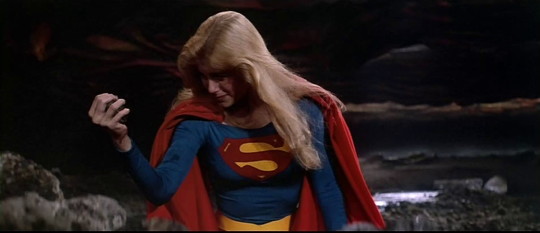
A draft of the movie’s script, dated Monday 17th January 1983, is available online, and it seems to mention scenes that never appeared in any publicly available cut of the film, including the Director’s Cut. The draft’s date is just a few weeks away from the alleged filming dates: Monday 18th April 1983 to Thursday 11th August 1983. The script does follow the story line of the finished movie, although it is apparent that some action segments have been reworked and some of the dialogue is only vaguely similar to the filmed version.
A second source of information comes from an apparently test audience viewing in the US, with online accounts of this screening at sites like IMDB seeming to bear out the rumours that some of the elements in the draft script may have been filmed and included in this screening.
Speculation suggests that a number of clips featuring Selena are still lost. These include more material with Selena and the Omegahedron, and a clip during Selena’s takeover of Midvale in which the angry townspeople are cowered (except Lucy) by Selena when she uses an ice spell to kill a woman.
There’s also speculation that two short interactions with Linda at school are absent. The first involves Nigel quizzing Linda about her plans for the weekend (this happens immediately before the scene, 50 minutes in, with Linda sitting outside the school as other girls leave with their parents, when Lucy invites Linda to join her later in Midvale.) The second is a chat between Linda and Lucy about clothes and fitting in on Earth.
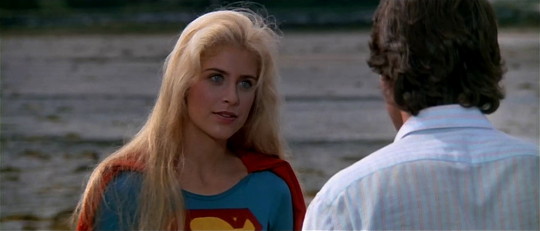
One interaction that always seemed a bit odd in the movie takes place immediately after the shower sequence (when Kara uses her heat vision to punish the two school bullies.) Entering their shared dorm room, Linda asks Lucy to comment on her new hairdo -- Lucy replies that it looks the same as before. In the script however (and in accounts of the advance screening) there is a segment with Supergirl using heat vision and a bathroom mirror to cut her blonde hair, but she forgets that she has reverted to Linda’s brunette wig when Lucy offers her critique. The second half of this interaction appears in the movie (albeit with different dialogue to the script), so fans have speculated that the laser haircut footage may exist too.
The January 1983 script also does a better job of tidying up the story’s loose ends. For example, rather than have Linda Lee just vanish without explanation, school principal (Fred?) Danvers uncovers Linda’s secret identity after she fights the energy monster, explaining why he won’t be frantically searching for her once Supergirl returns to Argo City. No accounts, rumoured or otherwise, suggest that these segments were filmed, however.

Conclusion
Even at 150 miniutes, Supergirl would still be a flawed movie. But then perhaps, as Jeannot Szwarc has noted, its intentions were never properly understood or promoted. The film isn’t trying to be the Christopher Reeve Superman, but rather a children’s fairy-tale in which the hero uses Kryptonian superpowers instead of magic. One internet commentator noted that Slater’s Supergirl is best enjoyed as a series of unconnected vignettes -- forget that the overall plot doesn’t make sense and just enjoy each scene on its own. I think there might be some truth in that analysis.
Despite its flaws, the 1984 Supergirl movie has amassed a loyal fanbase. The special effects are superb (even Richard Donner apparently admitted that the technique Szwarc used to make his Girl of Steel fly was superior to the zooming-lenses trick pioneered on Superman), the story is unapologetically lighthearted, and Helen Slater’s endearing portrayal as the Maid of Might is still considered by many to be the definitive live-action Supergirl.
Restoring the extra footage won’t overturn the movie’s shortcomings, but it will further soothe some of its inconsistencies, while sprinkling just a little more magic dust onto what its loyal fans already consider to be a charming and bewitching cinematic experience.
The movie’s heroine succeeds in her quest to find the Omegahedron and restore Argo City to its former glory -- we can but hope that one day her fans will find any missing footage, and restore her movie to its fullest length.
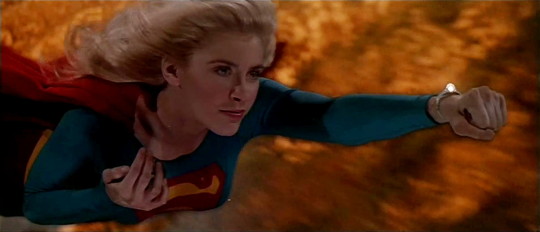
Timeline:
124 min (2h 04m) international theatrical release, July 1984.
105 min (1h 45m) US theatrical release, November 1984.
125 min (2h 05m) Japanese LaserDisc, late 1984.
105 min (1h 45m) initial US VHS release, 1985.
92 min (1h 32m) HBO / ABC television cut, 1987.
89 min (1h 29m) VHS release, unknown date (1991 perhaps?)
124 min (1h 04m) Anchor Bay VHS release, 1998.
138 min (2 hrs 18 mins) Director’s Cut DVD release, Summer 2000.
150 min (2 hrs 30 mins) speculated original cut, as yet undiscovered.
Sources:
imdb.com : Supergirl main page.
imdb.com : Supergirl alternative footage.
movie-censorship.com : Supergirl International vs Director’s Cut.
supermancinema.co.uk : List of VHS and tv cuts.
maidofmight.net : Director Jeannot Szwarc interview.
Thanks to Corrine, aka supergirldiaries, for the initial inspiration.
11 notes
·
View notes
Photo

#inspiredaily #dawsonscreek #90s @people Can you believe it's been 25 years since the premiere of Dawson's Creek? 🤯 Find out what the cast is up to these days by tapping the link in our bio! | 📷: Columbia/TriStar International Television; Frank Ockenfels/Warner Bros/REX/Shutterstock; Everett https://www.instagram.com/p/CnuCFnmu0eZ/?igshid=NGJjMDIxMWI=
0 notes
Text
If Sony had its own streaming service
First we had Netflix, Hulu, and Amazon Prime, then since Disney+ launched November 15, 2019, other major studios started having their own streaming services like HBO Max for Warner Bros. and MGM, Peacock for Universal Pictures (and later Illumination and DreamWorks Animation), and Paramount+ (which was originally CBS All Access until “The SpongeBob SquarePants Movie 4: Sponge on the Run” was released theatrically and digitally on March 5, 2021, and the service was later rebranded as Paramount+). So, that leaves Sony Pictures Entertainment as the only other major studio left. That said, what if Sony had their own streaming service similar to those other ones?
I would call Sony’s streaming service as simply “Sony+”. It would be a digital streaming service solely for movies and TV shows made by Columbia Pictures and/or TriStar, essentially any production made under Sony.
AVAILABLE AT LAUNCH
Animated films would be available to stream at launch, including Sony Pictures Animation films. Live action films made by either Columbia Pictures or TriStar are also available at launch. This also applies to theatrical films Sony will release in theaters on the same time they are available on Sony+.
ORIGINAL PROGRAMMING
Next to releasing existing Sony television programs at launch, Sony can also produce shows for the service as well.
PLAYSTATION COMPATIBILITY
Depending on when Sony should make Sony+ and release it on the digital market, it’s possible to have the service available for free on PlayStation 5, or whenever the next PlayStation console will come out. And exclusively for PlayStation consoles, there can be an exclusive category titled “PlayStation+”, for streaming PlayStation-exclusive titles from PlayStations 1-5. Think of it as like Steam or Nintendo Switch Online in a sense.
With PlayStation+, you can stream titles from those consoles to try out. And if you like whatever titles are available, you can star them and put them in your favorites list. There’s also the possibility of playing with friends locally and through online play depending on who else has Sony+.
0 notes
Text
Screenwriter, Producer and Author Steven L. Sears on 9/14 - Saturday
This virtual event will provide valuable insights and tips on crafting compelling scripts for film and television production, including, the intricacies of developing unique characters, a strong premise and story, finding your voice, exploring script development and the writer’s vision.


Steven L. Sears has worked as a Writer, Story Editor, Producer and Creator in Television, Film, digital media and animation. His lengthy career has encompassed over fifteen separate Television series, and development deals with many major studios in the industry, including Columbia Studios, Sony/Tristar Television, Rhysher Entertainment, Artists Inc., Cookie Jar Entertainment, Digital Pictures and many others.
More detailed Info here.
#scriptwriting#screenwriting#script#write#script chat#amwriting#writing community#writing corner#writers of tumblr#writers on tumblr#writers on writing#scriptwriters network#screenwriters network
0 notes
Photo

Terry Jones obituary
One morning Brian Cohen, completely naked, flung open the shutters at his bedroom window to find a mob below hailing him as the Messiah. Mrs Cohen, played by Terry Jones, who has died aged 77, had something to say about that. “He’s not the Messiah. He’s a very naughty boy,” she told the disappointed crowd. It became a classic cinema moment.
The 1979 film Monty Python’s Life of Brian, a satire about an ordinary Jewish boy mistaken for the Messiah, which Jones directed and co-wrote with his fellow Pythons Graham Chapman, John Cleese, Terry Gilliam, Eric Idle and Michael Palin, was banned by 39 British local authorities, and by Ireland and Norway. Jones and his chums were unrepentant: they even launched a Swedish poster campaign with the slogan: “So funny it was banned in Norway.”
As for Jones’s performance as Mandy Cohen, it united two leading facets of the funnyman’s repertoire: his fondness for female impersonation, and his passion for historical revisionism. The latter was evident not just in his work for Monty Python – in which his historian’s sensibility proved essential to the satire of Arthurian England in Monty Python and the Holy Grail (1975), which he co-directed and co-wrote – but also in several documentaries and books in which he stood up for what he took to be the misrepresented Middle Ages.
“We think of medieval England as being a place of unbelievable cruelty and darkness and superstition,” he said. “We think of it as all being about fair maidens in castles, and witch-burning, and a belief that the world was flat. Yet all these things are wrong.”
Arguably, without Jones, Monty Python’s Flying Circus (1969-74) would not have revolutionised British TV comedy. He was key in developing the show’s distinctively trippy, stream-of-consciousness format, where each surreal set-up (the Lumberjack Song, the upper-class twit of the year show, the dead parrot, or the fish-slapping dance) flowed into the next, unpunctuated by punchlines.
For all his directorial flair, though, Jones may well be best remembered for creating such characters as Arthur “Two Sheds” Jackson, Cardinal Biggles of the Spanish Inquisition, the Scottish poet Ewan McTeagle and the monstrous musician rodent beater in the mouse organ sketch who hits specially tuned mice with mallets.
Thanks to the show’s success, Jones was able to diversify into working as a writer, poet, librettist, film director, comedian, actor and historian. “I’ve been very lucky to have been able to act, write and direct and not have to choose just the one thing,” he said.
Jones was a second world war baby, born in Colwyn Bay, north Wales, and brought up by his mother, Dilys (nee Newnes), and grandmother, while his father, Alick Jones, was stationed with the RAF in India. He recalled meeting his father for the first time when he returned from war service: “Through plumes of steam at the end of the platform, he appeared – this lone figure in a forage cap and holding a kit bag. He ran over and kissed my mum, then my brother, then bent down and picked me up and planted one right on me. I’d only ever been kissed by the smooth lips of a lady up until that point, so his bristly moustache was quite disturbing.”
When he was four, the family moved to Surrey so his father could take up an appointment as a bank clerk. Terry attended primary school in Esher and the Royal Grammar school in Guildford. He studied English at St Edmund Hall, Oxford, and developed a lifelong interest in medieval history as a result of reading Chaucer.
At Oxford, he started the Experimental Theatre Company with his friend and contemporary Michael Rudman, performing everything from Brecht to cabaret. He also met Palin and the historian Robert Hewson, and collaborated with them on a satire on the death penalty called Hang Down Your Head and Die. It was set in a circus ring, with Jones playing the condemned man. He and Palin then worked together on the Oxford Revue, a satirical sketch show they performed at the 1964 Edinburgh festival, where he met David Frost as well as Chapman, Idle and Cleese.
After graduation, he was hired as a copywriter for Anglia Television and then taken on as a script editor at the BBC, where he worked as joke writer for BBC2’s Late Night Line-Up (1964-72). Jones and Palin became fixtures on the booming TV satire scene, writing for, among other BBC shows, The Frost Report (1966-67) and The Kathy Kirby Show (1964), as well as the ITV comedy sketch series Do Not Adjust Your Set (1967-69).
In 1967, he and Palin were invited to write and perform for Twice a Fortnight, a BBC sketch show that provided a training ground not only for a third of the Pythons (Jones and Palin), but two-thirds of the Goodies (Graeme Garden and Bill Oddie) and the co-creator of the 1980s political sitcom Yes Minister, Jonathan Lynn.
Jones and Palin wrote and starred in The Complete and Utter History of Britain (1969) for LWT. Its conceit was to relate historical incidents as if TV had existed at the time. In one sketch, Samuel Pepys was a chat show host; in another, a young couple of ancient Britons looking for their first home were shown around the brand-new Stonehenge. “It’s got character, charm – and a slab in the middle,” said the estate agent.
In the same year, he became one of the six founders of Monty Python’s Flying Circus. They expected the show to be quickly decommissioned by BBC bosses. “Every episode we’d be there biting our nails hoping someone might find it funny. Right up until the middle of the second series John Cleese’s mum was still sending him job adverts for supermarket managers cut out from her local newspaper,” Jones recalled. “It was only when they started receiving sackfuls of correspondence from school kids saying they loved it that we knew we were saved.”
After Python finished its run on TV, Jones went on to direct several films with the troupe. The first, Monty Python and the Holy Grail, was, he recalled, “a disaster when we first showed it. The audiences would laugh for the first five minutes and then silence, nothing. So we re-cut it. Then we’d show it in different cities, saying, ‘We’re worried about our film, would you come and look at it?’ And as a result people would come and they’d all be terribly worried about it too, so it was a nightmare.”
He had more fun co-writing and directing two series for the BBC called Ripping Yarns (1976-79) in which Palin starred as a series of heroic characters in mock-adventure stories, among them Across the Andes by Frog, and Roger of the Raj, sending up interwar literature aimed at schoolboys.
Jones directed and starred in Monty Python’s Life of Brian, which some religious groups denounced for supposedly mocking Christianity. Jones defended the film: “It wasn’t about what Christ was saying, but about the people who followed him – the ones who for the next 2,000 years would torture and kill each other because they couldn’t agree on what he was saying about peace and love.”
In 1983 he directed Monty Python’s The Meaning of Life, in which he made, perhaps, his most disgusting appearance, as Mr Creosote, a ludicrously obese diner, who is served dishes while vomiting repeatedly.
During this decade Jones diversified, proving there was life after Python. In 1980, he published Chaucer’s Knight: The Portrait of a Medieval Mercenary, arguing that the supposed paragon of Christian virtue could be demonstrated to be, if one studied the battles Chaucer claimed he was involved in, a typical, perhaps even vicious, mercenary. He also set out to overturn the idea of Richard II presented in the work of Shakespeare “who paints him more like sort of a weak … unmanly character”. Jones portrayed the king as a victim of spin: “There’s a possibility that Richard was actually a popular king,” he said.
He wrote children’s books, starting with The Saga of Erik the Viking (1983), which he composed originally for his son, Bill. A book of rhymes, The Curse of the Vampire’s Socks (1989), featured such characters as the Sewer Kangaroo and Moby Duck.
In 1987, he directed Personal Services, a film about the madam of a suburban brothel catering for older men, starring Julie Walters. The story was inspired by the experiences of the Streatham brothel-keeper Cynthia Payne. Jones proudly related that three of four films banned in Ireland were directed by him – The Life of Brian, The Meaning of Life and Personal Services.
Two years later, he directed Erik the Viking, a film adaptation of his book, with Tim Robbins in the title role of a young Norseman who declines to go into the family line of raping and pillaging. In 1996, he adapted Kenneth Grahame’s Wind in the Willows for the big screen, giving himself the role of Mr Toad, with Ratty and Mole played by Idle and Steve Coogan. But it was rarely screened in cinemas. “It was ruined by studio politicking between Disney and Columbia Tristar,” he said. “We made a really nice film but no one saw it. It didn’t make any money, even though it was well reviewed.”
Jones was also unfortunate with his next film project. Absolutely Anything, based on a script he wrote with the screenwriter Gavin Scott, concerned aliens coming to Earth and giving one person absolute power. Plans were scuppered when a movie with a similar premise, Bruce Almighty, starring Jim Carrey, was released in 2003. Only in 2015 did Jones manage to film Absolutely Anything, in which Simon Pegg, playing a mild-mannered schoolteacher, is given miraculous powers by a council of CGI aliens voiced by Jones and his former Monty Python colleagues. Robin Williams, in one of his last roles, voiced Pegg’s dog.
Jones made well-received history documentaries, including in 2002 The Hidden History of Egypt, The Hidden History of Rome and The Hidden History of Sex & Love, in which he examined the diets, hygiene, careers, sex lives and domestic arrangements of the ancient world, often appearing in the films as an ancient character, sometimes dressed as a woman.
In his book Who Murdered Chaucer? (2003), he wondered if the poet had been killed on behalf of King Henry IV for being politically troublesome.
He wrote for the Guardian, about the poll tax, nuclear power and the ozone layer. He became a vocal opponent of the Iraq war, and his articles on the subject were collected under the title Terry Jones’s War on the War on Terror (2004).
In his 2006 BBC series Barbarians, Jones sought to show that supposedly primitive Celts and savage Goths were nothing of the kind and that the ancient Greeks and Persians were neither as ineffectual nor as effete as the ancient Romans supposed. Best of all, he sought to demonstrate that it was not the Vandals and other north European tribes who destroyed Rome but Rome itself, thanks to the loss of its African tax base.
When Jones was asked what he would like on his tombstone, he did not want to be remembered as a Python, perhaps surprisingly, but for his writing and historical work. “Maybe a description of me as a writer of children’s books or maybe as the man who restored Richard II’s reputation. I think those are my best bits.”
In 2016, it was announced that Jones had been diagnosed with primary progressive aphasia, a form of dementia that impairs the ability to communicate. He and his family and friends spoke about his experiences to help others living with the condition.
Jones is survived by his second wife, Anna (nee Söderström), whom he married in 2012, and their daughter, Siri; and by Bill and Sally, the children of his first marriage, to Alison Telfer, which ended in divorce.
• Terence Graham Parry Jones, writer, actor and director, born 1 February 1942; died 21 January 2020
Daily inspiration. Discover more photos at http://justforbooks.tumblr.com
29 notes
·
View notes
Text
75 "Hot Guy Things" That Definitely Aren't "Hot Guy Things" Anymore
75 “Hot Guy Things” That Definitely Aren’t “Hot Guy Things” Anymore
We’ve come a long, long way. 1. Guys who lost the battle with their flat iron: Jeffrey Mayer / WireImage / Getty Images 2. Guys with this “bangs for days” haircut: Frazer Harrison / Getty Images 3. Guys who took style cues from Ronald McDonald: Rick Diamond / WireImage / Getty Images 4. Guys who just, like, dry humped the air in a conga line: Columbia TriStar Television…

View On WordPress
0 notes
Text
Disguise Announces New Worldwide Costume and Costume Accessories Program Based on Hit Series Cobra Kai
POWAY, Calif.–(SERVICE WIRE)–Leading toy and customer items maker, JAKKS Pacific, Inc. today revealed that it has actually participated in a contract with Sony Pictures Consumer Products, for its outfit department Disguise, Inc. to produce outfits based upon the hit series Cobra Kai. Disguise will create, market, manufacture and disperse a complete series of Cobra Kai outfits and outfit devices starting in 2021. The extremely well-known funny series has 30 episodes under its belt and an approaching 4th season this December on Netflix. These outfits will be offered this year solely at Walmart with growth of the line and retail partners prepared for 2022.
“The rise of Cobra Kai has been so fun to watch, beginning with its Karate Kid roots, and Disguise is ecstatic to be working with Sony Pictures Consumer Products on a new global costume range to support the massively successful show. We anticipate that there will be many karate dojo couples and group costumes planned for Halloween 2021 and beyond, as the iconic Cobra Kai outfits are both fun and comfortable to wear, and will be sure to be a hit with fans of all ages.” stated Tara Hefter, President and GM of Disguise, Inc.
Owned by JAKKS Pacific, Inc (NASDAQ:JAKK), Disguise is a world leader in style and advancement of innovative and cutting edge outfits and devices with circulation throughout the world. With Disguise’s continued commitment to information and quality, this brand-new line of Cobra Kai outfits makes certain to strike the mark with both clients and merchants alike.
About Sony Pictures Consumer Products
Sony Pictures Consumer Products (SPCP) is the licensing and retailing department of Sony Pictures’ Motion Picture Group and Sony Pictures Television for Sony Pictures Entertainment (SPE), a subsidiary of Tokyo-based Sony Group Corporation. SPE’s international operations incorporate movie production, acquisition, and circulation; tv production, acquisition, and circulation; tv networks; digital material development and circulation; operation of studio centers; and advancement of brand-new home entertainment items, services and innovations. Sony Pictures Television runs lots of wholly-owned or joint-venture production business all over the world. SPE’s Motion Picture Group production companies consist of Columbia Pictures, Screen Gems, TriStar Pictures, 3000 Pictures, Sony Pictures Animation, Stage 6 Films, AFFIRM Films, Sony Pictures International Productions, and Sony Pictures Classics. For extra info, see http://www.sonypictures.com/corp/divisions.html
About Cobra Kai
In the highly-anticipated return of 2 renowned characters, the arch-rivals from the famous Karate Kid movie series reunite over thirty years after the occasions of the 1984 All Valley Karate Tournament. Now living in the upscale hills of Encino, Daniel LaRusso (Ralph Macchio) leads an excellent life with his stunning household, while running an effective string of automobile dealers throughout the valley. Meanwhile, his high school enemy, Johnny Lawrence (William Zabka), whose life has actually taken a rocky turn, looks for redemption by resuming the notorious Cobra Kai karate dojo. Their lives undoubtedly ended up being linked and the competition is reignited, stating the next generation of “karate kids” in COBRA KAI. COBRA KAI is composed and executive produced by Josh Heald, Jon Hurwitz, and Hayden Schlossberg by means of their production business, Counterbalance Entertainment. COBRA KAI is produced by Overbrook Entertainment in association with Sony Pictures Television.
About Disguise, Inc.:
Since 1987, Disguise has actually been a leader in the Halloween market developing ingenious and pattern setting outfits and devices. Based in San Diego, Disguise produces outfits and devices under a lot of the world’s leading certified brand names, in addition to its own exclusive brand names for the country’s biggest merchants consisting of specialized, celebration and appear shops. Disguise styles and makes countless outfits for U.S. and other global markets each year bringing smiles and developing memories for kids and grownups alike. To see Disguise’s comprehensive Halloween collection, please see www.disguise.com and follow us on Instagram (@disguise.outfits), Twitter (@DisguiseInc) and Facebook (Disguise Costumes).
Disguise is a hallmark of Disguise, Inc.
About JAKKS Pacific, Inc.:
JAKKS Pacific, Inc. is a leading designer, maker and online marketer of toys and customer items offered throughout the world, with its head office in Santa Monica, California. JAKKS Pacific’s popular exclusive brand names consist of; Fly Wheels

, Kitten Catfe

, Perfectly Cute

, Renovate

Skateboard Co, X-Power

, Disguise®, Moose Mountain®, Maui®, Kids Only!®; a wide variety of entertainment-inspired items including leading certified residential or commercial properties; and C’est Moi

, a brand-new generation of tidy charm. Through JAKKS Cares, the business’s dedication to philanthropy, JAKKS is assisting to make a favorable influence on the lives of kids. Visit us at www.jakks.com and follow us on Instagram (@jakkstoys), Twitter (@jakkstoys) and Facebook (JAKKS Pacific).
©2020 JAKKS Pacific, Inc. All rights booked.
Source link
from Skate World. Skateboard News, skateboard shop https://ift.tt/3zwLmVE
0 notes
Text
New Post has been published on Otaku Dome | The Latest News In Anime, Manga, Gaming, Tech, and Geek Culture
New Post has been published on https://otakudome.com/underworld-5-film-uhd-collection-announced/
Underworld 5-Film UHD Collection Announced

Sony has announced the Underworld 4K UHD Collection:
The eternal battle between vampires and Lycans gets upgraded when the UNDERWORLD 4K ULTRA HD COLLECTION arrives on October 5th from Sony Pictures Home Entertainment. This limited edition gift set marks the first time that fans will be able to experience all five films on 4K Ultra HD disc with High Dynamic Range and Dolby Atmos audio. The films will also be available digitally in 4K with HDR.
The UNDERWORLD 4K ULTRA HD COLLECTION will include Underworld (both the original theatrical version and the extended cut), Underworld: Evolution, Underworld: Rise of the Lycans, Underworld: Awakening and Underworld: Blood Wars, as well as hours of SD & HD bonus content across all five films, including the Underworld: Endless War animated shorts.
This must-own gift set is a limited edition, presented within a collectible outer slipcase.
UNDERWORLD BONUS FEATURES
4K ULTRA HD
Theatrical & Extended Versions of the Film (both 4K HDR and Dolby Atmos)
Alternate Flashbacks (4K HDR)
Theatrical Trailer
BLU-RAY
Extended Version of the Film
Director & Cast Commentary
Fang vs. Fiction Documentary
7 Featurettes
Outtakes
Storyboard Comparisons
Music Video: “Worms of the Earth” by Finch
UNDERWORLD: EVOLUTION BONUS FEATURES 4K ULTRA HD
Theatrical Trailer
BLU-RAY
Director & Filmmakers’ Commentary
The Hybrid Theory
The War Rages On
Bloodlines: From Script to Screen
Making Monsters Roar
Building a Saga
Music and Mayhem
Music Video: “Her Portrait in Black” by Atreyu
UNDERWORLD: RISE OF THE LYCANS BONUS FEATURES 4K ULTRA HD
Rise of the Lycans: Inside the Castle Walls
Theatrical Trailers
BLU-RAY
Behind the Castle Walls: Picture-in-Picture Experience
Filmmaker Commentary
3 Featurettes
Music Video: “Deathclub (Wes Borland / Renholder Remix)” by William Control feat. Matt Skiba
And More
UNDERWORLD: AWAKENING BONUS FEATURES 4K ULTRA HD
Underworld: Endless War 3-Part Animated Series (with stereo DTS-HD MA English audio)
Theatrical Trailers
BLU-RAY
Cracking the Underworld: Picture-in-Picture Experience
Filmmakers’ Commentary
5 Featurettes
Blooper Reel
And More
UNDERWORLD: BLOOD WARS BONUS FEATURES 4K ULTRA HD
Franchise Recap
Theatrical Trailers
BLU-RAY
Underworld: Blood Wars – The Official Movie Graphic Novel
The Evolution of Selene
Building a Blood War
Old & New Blood
The Evil Evolved
SPECS
4K Ultra HD: All films presented in 2160p Ultra High Definition with HDR 10 and Dolby Atmos immersive audio + DTS-HD MA 5.1 original theatrical audio tracks (DTS-HD MA 7.1 for UNDERWORLD: AWAKENING); aspect ratios vary Blu-ray: All films presented at 1080p High Definition resolution; aspect ratios and audio configurations vary Ratings:
Underworld: Theatrical Cut: R for strong violence / gore and some language; Extended Cut: Unrated
Underworld: Evolution: R for pervasive strong violence and gore, some sexuality / nudity and language
Underworld: Rise of the Lycans: R for bloody violence and some sexuality
Underworld: Awakening: R for strong violence and gore, and for some language
Underworld: Blood Wars: R for strong bloody violence, and some sexuality
FOR MORE INFORMATION Twitter: https://www.twitter.com/UnderworldMovie Facebook: https://www.facebook.com/UnderworldMovie
ABOUT SONY PICTURES ENTERTAINMENT Sony Pictures Entertainment (SPE) is a subsidiary of Tokyo-based Sony Corporation. SPE’s global operations encompass motion picture production, acquisition, and distribution; television production, acquisition, and distribution; television networks; digital content creation and distribution; operation of studio facilities; and development of new entertainment products, services and technologies. SPE’s Motion Picture Group production organizations include Columbia Pictures, Screen Gems, TriStar Pictures, Sony Pictures Animation, Stage 6 Films, AFFIRM Films, and Sony Pictures Classics. For additional information, visit http://www.sonypictures.com/corp/divisions.html.
0 notes
Photo

Dark Horse Entertainment/Columbia TriStar Television (1999) The content shown in this video is not... #surnativa #columbiatristartelevision #darkhorseentertainment #logocaptures #pepsi9072 Source: https://surnativa.com/dark-horse-entertainment-columbia-tristar-television-1999/?feed_id=38638&_unique_id=5f692d0922f00
0 notes